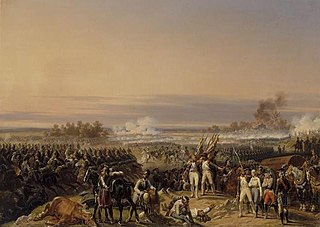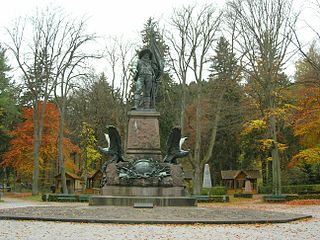
The history of Tyrol, a historical region in the middle alpine area of Central Europe, dates back to early human settlements at the end of the last glacier period, around 12,000 BC. Sedentary settlements of farmers and herders can be traced back to 5000 BC. Many of the main and side valleys were settled during the early Bronze Age, from 1800 to 1300 BC. From these settlements, two prominent cultures emerged: the Laugen-Melaun culture in the Bronze Age, and the Fritzens-Sanzeno culture in the Iron Age.

The Battle of Höchstädt was fought on 19 June 1800 on the north bank of the Danube near Höchstädt, and resulted in a French victory under General Jean Victor Marie Moreau against the Austrians under Baron Pál Kray. The Austrians were subsequently forced back into the fortress town of Ulm. Instead of attacking the heavily fortified, walled city, which would result in massive losses of personnel and time, Moreau dislodged Kray's supporting forces defending the Danube passage further east. As a line of retreat eastward disappeared, Kray quickly abandoned Ulm, and withdrew into Bavaria. This opened the Danube pathway toward Vienna.

The French Revolutionary Wars were a series of sweeping military conflicts resulting from the French Revolution that lasted from 1792 until 1802. They pitted France against Great Britain, Austria, Prussia, Russia, and several other countries. The wars are divided into two periods: the War of the First Coalition (1792–1797) and the War of the Second Coalition (1798–1802). Initially confined to Europe, the fighting gradually assumed a global dimension. After a decade of constant warfare and aggressive diplomacy, France had conquered territories in the Italian Peninsula, the Low Countries and the Rhineland. French success in these conflicts ensured the spread of revolutionary principles over much of Europe.

The Battle of Sacile on 16 April 1809 and its companion Clash at Pordenone on 15 April saw an Austrian army commanded by Archduke John of Austria defeat a Franco-Italian army led by Eugène de Beauharnais and force it to retreat. Sacile proved to be the most notable victory of John's career. The action took place east of the Livenza River near Sacile in modern-day Italy during the War of the Fifth Coalition, part of the Napoleonic Wars.
The French Revolutionary Wars continued from 1795, with the French in an increasingly strong position as members of the First Coalition made separate peaces. Austria and Great Britain were the main remaining members of the coalition. The rebellion in the Vendée was also finally terminated by General Hoche.

Malborghetto Valbruna is a comune (municipality) in the Regional decentralization entity of Udine in Friuli-Venezia Giulia, north-east Italy.

The Battles of Bergisel were four battles fought between Tyrolese civilian militiamen and a contingent of Austrian government troops and the military forces of Emperor Napoleon I of France and King of Kingdom of Bavaria against at the Bergisel hill near Innsbruck. The battles, which occurred on 25 May, 29 May, 13 August, and 1 November 1809, were part of the Tyrolean Rebellion and the War of the Fifth Coalition.

Giovanni Marchese di Provera or Johann Provera served in the Habsburg Austrian army in Italy during the French Revolutionary Wars, rising to command a 9,000-man independent corps during the War of the First Coalition. Previously, he fought in the Seven Years' War, the War of the Bavarian Succession, and the Austro-Turkish War. In 1796–1797, Provera played a significant role in three Italian campaigns against the Republican French army of Napoleon Bonaparte.

During the siege of Mantua, which lasted from 4 June 1796 to 2 February 1797 with a short break, French forces under the overall command of Napoleon Bonaparte besieged and blockaded a large Austrian garrison at Mantua for many months until it surrendered. This eventual surrender, together with the heavy losses incurred during four unsuccessful relief attempts, led indirectly to the Austrians suing for peace in 1797. The siege occurred during the War of the First Coalition, which is part of the French Revolutionary Wars. Mantua, a city in the Lombardy region of Italy, lies on the Mincio River.
Joseph Ocskay von Ocskó joined the army of the Habsburg monarchy and rose to the rank of general officer during the French Revolutionary Wars. He fought in numerous actions in the 1796–1797 Italian campaign against the French army commanded by Napoleon Bonaparte. In particular, he led a combat brigade during the first, third, and fourth Austrian attempts to relieve the Siege of Mantua.

Baron Josef Philipp Vukassovich was a Croatian soldier who joined the army of Habsburg monarchy and fought against both Ottoman Empire and the First French Republic. During the French Revolutionary Wars, he commanded a brigade in the 1796–1797 Italian campaign against Napoleon Bonaparte. He led a division during the Napoleonic Wars and received a fatal wound in action.

Anton Ferdinand Freiherr Mittrowsky von Mittrowitz und Nemyšl, or Anton Mittrowsky, was promoted to general officer in the spring of 1796, just in time to lead a brigade against Napoleon Bonaparte during the 1796–1797 Italian Campaign in the War of the First Coalition. He served as a regimental commander in 1792–1796, leading his unit at Neerwinden, Famars, and Le Quesnoy in 1793. In the following year, he led the regiment at Landrecies, Beaumont, Courtrai, and Fleurus. In 1796, he led a brigade at Castiglione and 2nd Bassano, and played a pivotal role at Arcole, nearly defeating Bonaparte. In 1799, he commanded troops at Verona, Magnano, Novi, and Genola. During the Napoleonic Wars he led forces at Caldiero in 1805. He became the Proprietor (Inhaber) of an Austrian infantry regiment from 1806 until his death three years later.

Heinrich XV, Prince Reuss of Greiz was the fourth of six sons born into the reigning family of the Principality of Reuss. At the age of fifteen he joined the army of the Habsburg monarchy and later fought against Ottoman Turkey. During the French Revolutionary Wars he became a general officer and saw extensive service. He commanded a corps during the Napoleonic Wars. From 1801 until his death, he was Proprietor (Inhaber) of an Austrian infantry regiment.

The Tyrolean Rebellion is a name given to the resistance of militiamen, peasants, craftsmen and other civilians of the County of Tyrol led by Andreas Hofer supported by his wife Anna and a strategic council consisting of Josef Speckbacher, Peter Mayr, Capuchin Father Joachim Haspinger, Major Martin Teimer and Kajetan Sveth, against new legislation and a compulsory vaccination programme concerning smallpox ordered by King Maximilian I of Bavaria, followed by the military occupation of their homeland by troops organised and financed by Napoleon I of the First French Empire and Maximilian I. The broader military context is called the War of the Fifth Coalition.

The Battle of Wörgl or Wörgel was fought on 13 May 1809, when a Bavarian force under French Marshal François Joseph Lefebvre attacked an Austrian Empire detachment commanded by Johann Gabriel Chasteler de Courcelles. The Bavarians severely defeated Chasteler's soldiers in series of actions in the Austrian towns of Wörgl, Söll, and Rattenberg. Wörgl is located 20 kilometres (12 mi) south of the modern-day German border on the upper Inn River.

The Battle of Tarvis from 16 to 17 May 1809, the Storming of the Malborghetto Blockhouse from 15 to 17 May 1809, and the Storming of the Predil Blockhouse from 15 to 18 May saw the Franco-Italian army of Eugène de Beauharnais attacking Austrian Empire forces under Albert Gyulai. Eugène crushed Gyulai's division in a pitched battle near Tarvisio, then an Austrian town known as Tarvis. At nearby Malborghetto Valbruna and Predil Pass, small garrisons of Grenz infantry heroically defended two forts before being overwhelmed by sheer numbers. The Franco-Italian capture of the key mountain passes allowed their forces to invade Austrian Kärnten during the War of the Fifth Coalition. Tarvisio is located in far northeast Italy, near the borders of both Austria and Slovenia.
Count Albert Gyulay de Marosnémethi et Nádaska or Albert Gyulai von Máros-Németh und Nádaska, born 12 September 1766 – died 27 April 1835, a Hungarian, joined the army of Habsburg Austria and fought against Ottoman Turkey. He served against the First French Republic in the Flanders Campaign and on the Rhine. Severely wounded in 1799, he survived a trepanning operation and briefly retired from military service. He returned to active service and commanded an army corps during the War of the Fifth Coalition, part of the Napoleonic Wars. He led his troops in several important battles during the Austrian invasion of Italy in 1809, including one where he was in independent command. Though appointed to command troops in 1813 and 1815, he missed combat in both campaigns. He was Proprietor (Inhaber) of an Austrian infantry regiment from 1810 until his death. The more famous Ignác Gyulay, Ban of Croatia was his older brother.
Alois Graf von Gavasini led a combat brigade in the armies of Habsburg Austria and the Austrian Empire during a remarkable number of battles in the French Revolutionary Wars and Napoleonic Wars. A native of Bonn, he offered his services to Austria and won an award for bravery in 1790. While a field officer in the Italian campaign, he led the rear guard at Primolano in September 1796. Badly outnumbered by the French, he and his soldiers put up a vigorous fight until he was wounded and captured. At Arcole in November 1796, he commanded a brigade on the field of battle against Napoleon Bonaparte's French army. Promoted to general officer in the spring of 1800, he led a powerful brigade at Hohenlinden during that year's fall campaign in Bavaria. Though the battle ended in a decisive defeat, Gavasini's troops fought well before being forced to retreat. The 1805 campaign in Italy found him directing a reserve brigade at Caldiero. After briefly retiring, the warrior returned to lead a brigade at the battles of Sacile, Piave River, and Graz during the 1809 war. That year he retired from the army and did not return.

The Battle of Tarvis was fought during 21–23 March 1797 near present-day Tarvisio in far northeast Italy, about 12 kilometres (7 mi) west-by-southwest of the three-border conjunction with Austria and Slovenia, and was the final battle before the end of the War of the First Coalition. In the battle, three divisions of a First French Republic army commanded by Napoleon Bonaparte attacked several columns of the retreating Habsburg Austrian army led by Archduke Charles, Duke of Teschen. In three days of confused fighting, French divisions directed by André Masséna, Jean Joseph Guieu, and Jean-Mathieu-Philibert Sérurier succeeded in blocking the Tarvis Pass and capturing 3,500 Austrians led by Adam Bajalics von Bajahaza. The engagement occurred during the War of the First Coalition, part of the French Revolutionary Wars.

In the Rhine campaign of 1796, two First Coalition armies under the overall command of Archduke Charles outmaneuvered and defeated two French Republican armies. This was the last campaign of the War of the First Coalition, part of the French Revolutionary Wars.


















